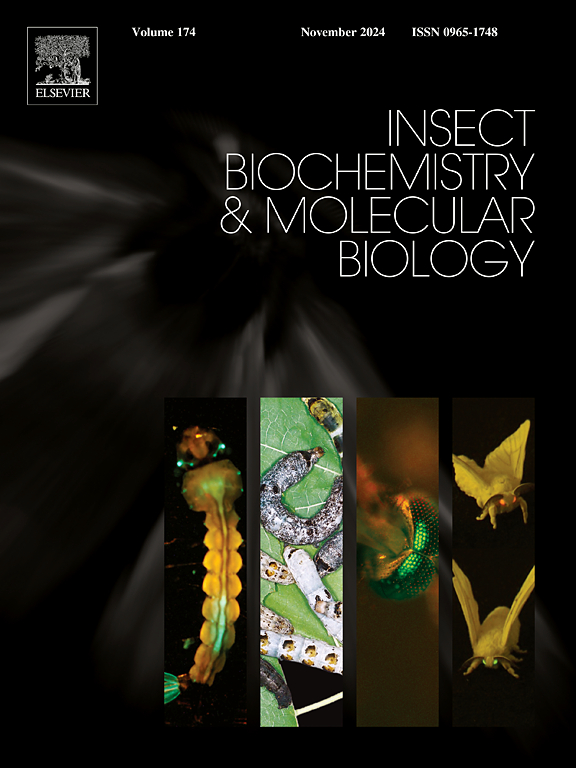抑制辣椒水疱谷氨酸转运蛋白的功能分析:谷氨酸转运和害虫管理的意义。
IF 3.7
2区 农林科学
Q2 BIOCHEMISTRY & MOLECULAR BIOLOGY
引用次数: 0
摘要
谷氨酸是动物主要的兴奋性神经递质,其储存和释放受哺乳动物水疱性谷氨酸转运蛋白(vGluTs)的调控。然而,vglut在农业害虫中的作用在很大程度上仍未被探索。在本研究中,我们成功克隆了水稻螟虫(RSB) Chilo suppressalis的全长vGluT基因。多序列比对结果表明,CsvGluT与其他已知昆虫vglut的氨基酸序列相似性超过69.82%。在系统发育树上,CsvGluT与亚洲玉米螟(Ostrinia furnacalis)聚为一个分支,后者也属于玉米螟科。时空表达分析表明,CsvGluT在幼虫头部高度表达,在1龄和2龄幼虫中表达量丰富,表达量是3 ~ 6龄幼虫的3倍以上。电生理记录表明,CsvGluT在高浓度质子和氯离子作用下表现出与哺乳动物vglut类似的功能特性。此外,哺乳动物vglut的抑制剂,包括evans蓝(EB)和4,4'-二异硫氰基二苯乙烯-2,2'-二磺酸(DIDS),显著抑制了CsvGluT的活性。RNA干扰(RNAi)介导的CsvGluT敲低可显著降低RSB的存活率至66%,突出了其生理作用和基于RNAi的RSB控制的潜在靶点。综上所述,我们的研究结果阐明了vGluT在RSB中的生理功能,为进一步研究基于rnai的转运蛋白靶向害虫防治策略提供了理论基础。本文章由计算机程序翻译,如有差异,请以英文原文为准。

Functional analysis of vesicular glutamate transporter in Chilo suppressalis: Implications for glutamate transport and pest management
Glutamate is the primary excitatory neurotransmitter in animals, and its storage and release are regulated by vesicular glutamate transporters (vGluTs) in mammals. However, the function of vGluTs in agricultural pests remains largely unexplored. In this study, we successfully cloned the full-length vGluT gene from the rice striped stem borer (RSB) Chilo suppressalis, a major rice pest. Multiple sequence alignment revealed that the amino acid sequence of CsvGluT shared more than 69.82 % similarity with other known insect vGluTs. In the phylogenetic tree, CsvGluT was clustered into a clade with the Asian corn borer Ostrinia furnacalis, which also belongs to Crambidae family. Spatial-temporal expression analysis showed that CsvGluT was highly expressed in the larval heads and abundant in the 1st- and 2nd-instar larvae, whose expression levels are more than three-fold higher than those in the 3rd- to 6th -instar larvae. Electrophysiological recordings indicated that CsvGluT exhibited functional properties like mammalian vGluTs under high concentrations of protons and chloride ions. Furthermore, inhibitors of mammalian vGluTs, including evans blue (EB) and 4,4′-diisothiocyanostilbene-2,2′-disulfonic acid (DIDS), significantly inhibited CsvGluT activity. RNA interference (RNAi)-mediated knockdown of CsvGluT significantly reduced the survival rate of RSB to 66 %, highlighting its physiological role and a potential target for RNAi-based RSB control. In summary, our findings elucidated the physiological function of vGluT in RSB and provide a theoretical foundation for advanced research in the development of RNAi-based transporter-targeted strategies for pest management.
求助全文
通过发布文献求助,成功后即可免费获取论文全文。
去求助
来源期刊
CiteScore
7.40
自引率
5.30%
发文量
105
审稿时长
40 days
期刊介绍:
This international journal publishes original contributions and mini-reviews in the fields of insect biochemistry and insect molecular biology. Main areas of interest are neurochemistry, hormone and pheromone biochemistry, enzymes and metabolism, hormone action and gene regulation, gene characterization and structure, pharmacology, immunology and cell and tissue culture. Papers on the biochemistry and molecular biology of other groups of arthropods are published if of general interest to the readership. Technique papers will be considered for publication if they significantly advance the field of insect biochemistry and molecular biology in the opinion of the Editors and Editorial Board.

 求助内容:
求助内容: 应助结果提醒方式:
应助结果提醒方式:


